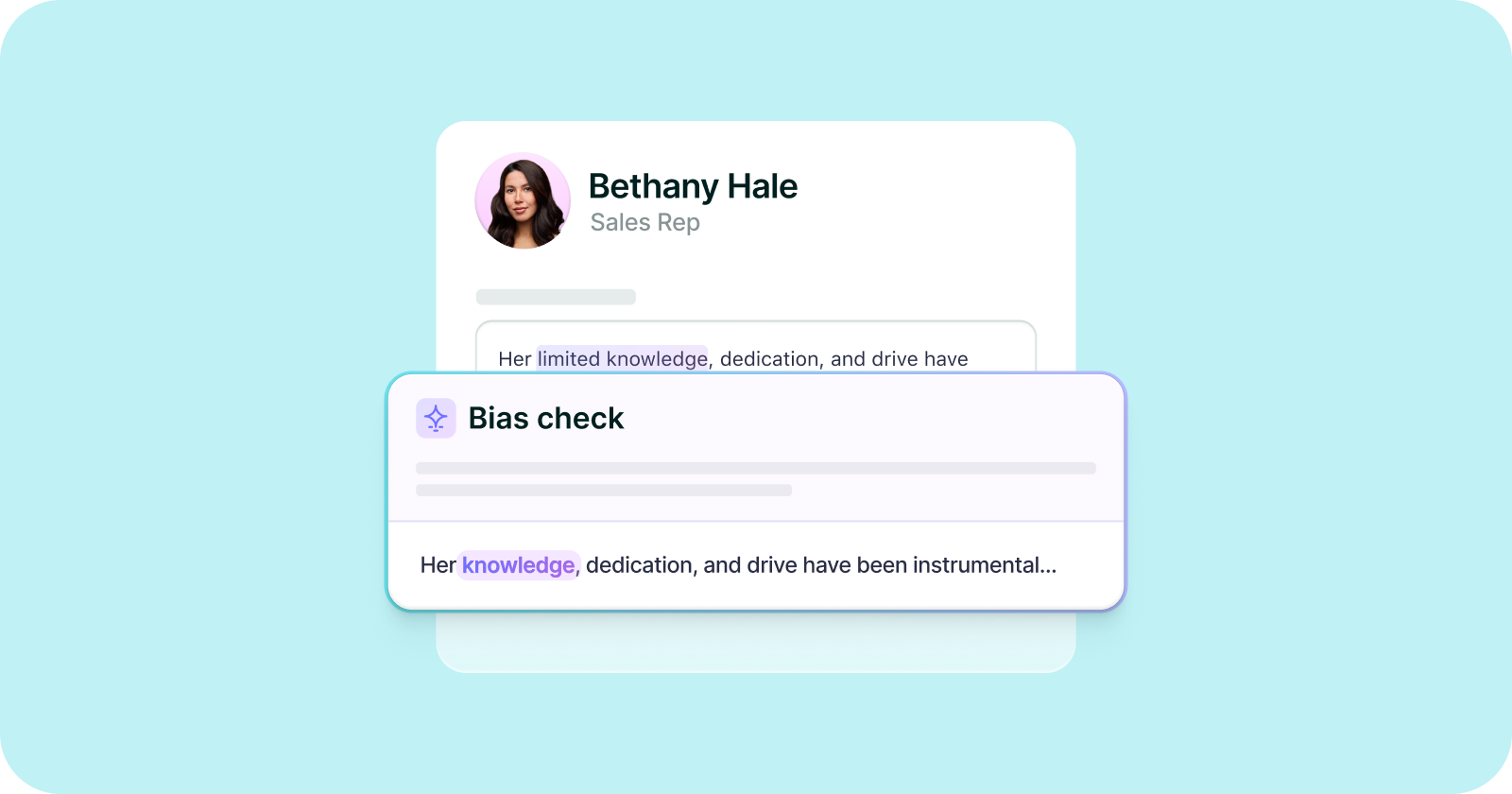When you think of building a more equitable workplace, giving feedback probably isn’t the first thing that comes to mind — but it actually shouldn’t be far from the top of the list.
Since equity means all individuals at the organization have an equal opportunity to succeed, feedback — information on how one is performing — is a key way to build or break equity in the workplace.
Below, we’ll explore why feedback is an equity issue and outline actionable steps you can take to ensure more equitable feedback at your organization.
{{rich-takeaway}}
Feedback is an equity issue.
Feedback tells employees how they’re performing in the workplace. It’s essential for motivating people and making them feel appreciated for the work they do, as well as for providing specific input about what they’ve done well and where they can improve.
Both explicit bias and unconscious bias can negatively impact how feedback is provided at an organization, and research shows that an individual’s demographic or identity group can impact the feedback they receive.
Biases are natural mental patterns in the human brain that arise from heuristics, which are cognitive shortcuts or “rules of thumb” that help our brains process information quickly and efficiently. While heuristics can be useful decision-making tools, biases represent systematic errors that occur when these mental shortcuts are misapplied or lead us away from accuracy and fairness.
Biases are sneaky. Their insidious reach goes far beyond the traditional negative implicit biases that first come to mind, like those tied to ethnicity, age, or social groups. They can emerge from seemingly helpful mental shortcuts (the aforementioned heuristics), like using recent examples to quickly assess performance or relying on first impressions to make efficient judgments. However, these same shortcuts can systematically disadvantage certain groups of employees when applied without awareness.
We can also be biased in favor of an individual. Similarity bias, also known as affinity bias, for example, is when we think of or rate an individual who shares characteristics with us more favorably.
Even though it’s normal to have biases, we must work to combat them to promote a more just, fair, and equitable workplace (and world).
Common Biases in the Workplace
Demographic biases tend to be more obvious. This is when an individual is favored or judged more harshly because of a demographic they belong to, such as gender, race, age, parental status, or sexual orientation. For example:
Cognitive biases tend to be trickier to spot. They include:
What Equitable Feedback Looks Like
Equitable feedback is clear, behavior-based, and actionable guidance that’s consistently applied across all employee groups, regardless of demographics or identity. While it’s easy to define equitable feedback, delivering it can be more difficult.
To write more equitable feedback, we must rid our comments of biases, but that’s not all. In general, we can look at equitable feedback as having five key characteristics.
- Specific and actionable: A 2022 survey by Textio found that groups that are least represented in business and leadership are the most likely to receive feedback that’s not actionable. Such feedback provides little developmental value, leaving employees without clear guidance on how to advance their careers or improve performance. Actionable feedback gives employees concrete steps they can take immediately, answering “What exactly should I do differently?” rather than leaving employees to guess what changes are needed.
- Timely: Feedback delivered soon after an event, rather than delayed until annual performance or mid-year reviews, tends to be more specific and useful because the context remains clear. Timely delivery also reduces the effects of recency bias, which can distort how managers remember and interpret events from longer ago.
- Behavior-focused: Feedback should focus on specific, observable behaviors that the receiver can control, as opposed to personality traits. Behavior is observable, measurable, and changeable, while personality is less visible and harder to change.
- Consistently applied: Feedback evaluated on clear performance standards creates equitable job performance expectations across your organization. Without feedback that is consistently applied, employees are likely to question the fairness of decision-making processes, like who gets stretch assignments or promotions.
- Growth-oriented: Educational research from 2020 suggests that feedback conversations that focus on future goals may boost an individual’s belief in their ability to meet said goals. Growth-oriented feedback creates environments where employees see performance conversations as learning opportunities rather than as punitive.
Core Strategies for Building Equitable Feedback
Building more equitable feedback practices requires combating bias as much as possible. But because biases are sneaky mental shortcuts, eradicating them isn't easy.
While reviewing for bias is important, it’s not sufficient. Organizations also need structured, formalized strategies for providing feedback and evaluating employees. Armed with a set of clear, shared criteria for rating performance, managers have a better chance of providing fair feedback.
Train managers.
While uncconscious bias training programs are an important part of educating managers on feedback practices, they’re just one aspect. Managers also need training on inclusive language and using bias interruption techniques, such as prompting AI to spot different types of bias.
Rather than teaching managers what not to do, consider training them on how to give good feedback. Frameworks like the Situation-Behavior-Impact (SBI)™ model or the COIN (connection, observation, impact, next steps) model are great places to start.
Calibrate feedback during review cycles.
Performance review calibration is the process of reviewing and adjusting employee performance ratings for fairness across teams. Organizations can use calibration teams or calibration workflows through their HRIS (like Lattice HRIS) to ensure manager reviews of employees are objectively verified.
Calibrating creates an opportunity to counter bias by asking for proof. For example, if one manager says, “I think Bob has really high potential,” calibration team members should ask, “Could you give us an example of one time you observed Bob’s high potential in action?”
Calibration can also be a place where bias becomes more pronounced, because people making decisions together can influence each other through groupthink or rely too heavily on recency bias. Again, to counter this, calibration facilitators should require concrete evidence for performance statements.
Collect more than one source for feedback.
Where calibration helps ensure feedback meets universally-agreed-upon performance criteria, gathering feedback from multiple sources can help counteract individual biases and create more balanced feedback. When employees receive input from managers, peers, direct reports, or cross-functional partners, the overall assessment becomes more balanced and comprehensive.
By implementing 360-degree reviews with peer feedback, organizations create opportunities for diverse teams to provide multiple perspectives.
If you’re not using a tool that is in the moment using AI to de-bias important communication, you are behind.
Using AI to Detect and Combat Bias
Generative AI’s near-omnipresence in the workplace presents both opportunities and considerations when it comes to performance reviews.
Large language models (LLMs), the ‘system’ behind tools like ChatGPT, Gemini, or Claude, are at risk of perpetuating any biases contained in the enormous amounts of data they’re trained on. At the same time, LLMs — especially specially trained ones — offer powerful capabilities for reducing bias.
“If you’re not using a tool that is in the moment using AI to de-bias important communication, you are behind,” said Liz Kofman-Burns, PhD, cofounder of Peoplism, a people strategy consulting firm.
At your own organization, you can use AI to create more objective performance management processes in a number of ways.
Real-time language and rating analysis: AI systems can examine performance reviews to identify biased language patterns or scoring inconsistencies. For example, if performance comments focus on personality traits rather than specific behaviors and outcomes, AI tools can detect this bias and recommend more fact-based, actionable alternatives that emphasize performance instead.
Comprehensive data integration: AI-powered performance platforms can synthesize information from multiple sources — one-on-ones, goal tracking, peer feedback, and project outcomes — to create a more complete performance picture. This reduces managers’ reliance on memory, helps temper recency bias, and supports evidence-based evaluations of employee performance.
Pattern recognition across the organization: AI can uncover systematic bias patterns in performance evaluations, promotion decisions, and compensation across different demographic groups, equipping leadership with the info needed to implement targeted interventions where disparities exist.
{{rich-highlight-1}}
Practical Examples of More Equitable Feedback
With some consideration of the strategies mentioned here and careful reframing, writing more equitable feedback gets easier.
To avoid personality-based feedback:
❌ Instead of: “You can be too aggressive in team meetings.”
✅ Try: “Part of your job is to manage stakeholders to move projects forward. I noticed when you spoke with X about Y, they expressed frustration for not being heard, walked away from the conversation, and subsequently did not meet the deadline for their deliverable. I have some ideas for how you might handle similar situations in the future.”
❌ Instead of: “You are a natural leader and have great executive presence.”
✅ Try: “In last Tuesday’s client presentation, you guided the discussion effectively by asking clarifying questions when the client seemed confused, and you kept the meeting on track when we started running over time. For future presentations, continue using those facilitation techniques as they really helped us secure the follow-up meeting. Well done!”
To avoid vague feedback:
❌ Instead of: “You need to improve your communication skills.”
✅ Try: “In this week’s team standup, I noticed you shared updates without providing context for stakeholders who weren't involved in your project. Next time, try starting with a brief background before diving into specifics. This will help everyone follow along and contribute more effectively.”
❌ Instead of: “Sam, you need to stop missing deadlines.”
✅ Try: “Sam, I want you to work on your time management. I noticed you missed three deadlines this month, on X, Y, and Z. I’ve also noticed that you’re often late for meetings, like last Thursday for a discovery call with our new client. Let’s discuss strategies for better time management.”
To ensure clear expectations:
❌ Instead of: “You need to show more ownership.”
✅ Try: “I’d welcome seeing you take more ownership of your deliverables. This includes assuming responsibility for their success or failure, proactively identifying potential project risks, and presenting solutions before issues escalate. One concrete step would be sending weekly status updates that include any blockers you’ve identified and your proposed next steps, rather than waiting for me to ask about progress.”
❌ Instead of: “You need to be more strategic in your thinking.”
✅ Try: “I’d love to see you demonstrate more strategic thinking in project proposals. This could involve analyzing how your project’s outcome would impact our quarterly goals and considering alternative approaches before implementation. For your next project proposal, please present at least two options with pros and cons, and explain how each aligns with our Q3 revenue targets.”
To give great positive feedback:
❌ Instead of: “Great job on the project!”
✅ Try: “Your project management on the client onboarding initiative was excellent. You proactively identified the potential delay with legal review and created a backup timeline, which kept us on track to meet the go-live date. This approach saved us two weeks and impressed the client team. Well done!”
❌ Instead of: “You’re really good with people.”
✅ Try: “In yesterday’s difficult conversation with the frustrated customer, you listened without interrupting, acknowledged their concerns specifically, and then walked them through three concrete solutions. Your approach turned a potential cancellation into a contract renewal. That active listening technique would be valuable to use in all challenging client interactions. Bravo!”
Feedback Pitfalls to Avoid When Building Inclusive Cultures
Equitable feedback creates powerful ripple effects that support a thriving organizational culture when done well. But organizations must avoid common pitfalls when it comes to feedback.
Overcorrection is particularly dangerous. Some managers, in an effort to be less biased, may swing too far in the opposite direction and give overly positive feedback. But this hyper-positivity can also be harmful, as it fails to provide the practical, growth-oriented feedback employees need to improve.
Taking a tools-only approach is problematic, too. While AI and structured frameworks are valuable, they can’t replace the need for comprehensive manager training and cultural change. Don’t assume technology alone will solve bias problems — it won’t.
Lastly, one-time efforts don’t lead to lasting change. Bias interruption must be an ongoing practice supported across the organization with resources and buy-in. Without sustained commitment, even well-intentioned initiatives will fade over time.
Building a More Equitable Future Through Better Feedback
Feedback is a powerful tool to drive performance and development, but only when it’s delivered fairly and consistently. By implementing structured approaches, training managers on bias awareness and how to combat it, leveraging AI-powered tools, and creating systems for shared conclusions, organizations can transform their feedback cultures. The result? Better performance, higher employee engagement, and more inclusive environments where all employees have the opportunity to grow and succeed.
Ready to transform your feedback culture?
Request a Lattice demo to see how Lattice Performance and Lattice AI can help reduce feedback bias, drive manager consistency, and support a culture of inclusion and growth.

AI For Writing Better, Less Biased Feedback
Bias is only human. AI isn't. Lattice automatically calls out problematic language in feedback and reviews. That means fairer, more equitable results for actual people.
Key Takeaways
- Feedback can create equity issues because of biases, which arise from mental shortcuts called heuristics. Biases systematically advantage or disadvantage certain employee groups, making structured feedback frameworks essential for fair evaluation.
- Equitable feedback focuses on specific, observable behaviors rather than personality traits, providing employees with actionable steps they can take immediately to improve performance.
- AI-powered tools, like Lattice, can identify biased language patterns in real-time and suggest objective alternatives, helping managers provide more equitable performance reviews.








